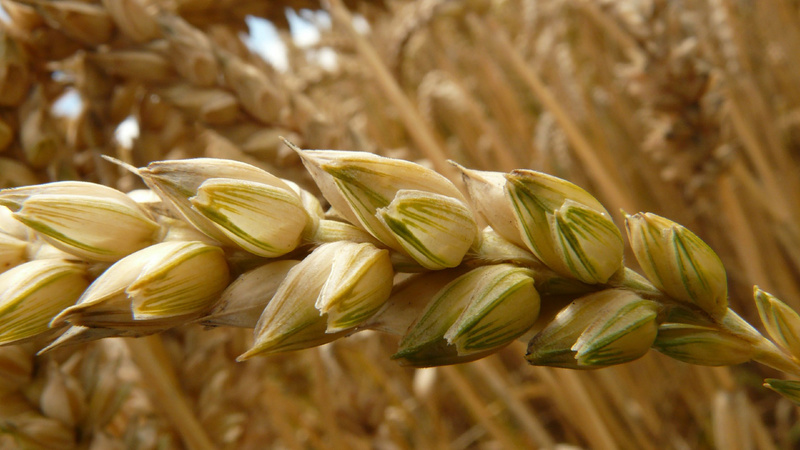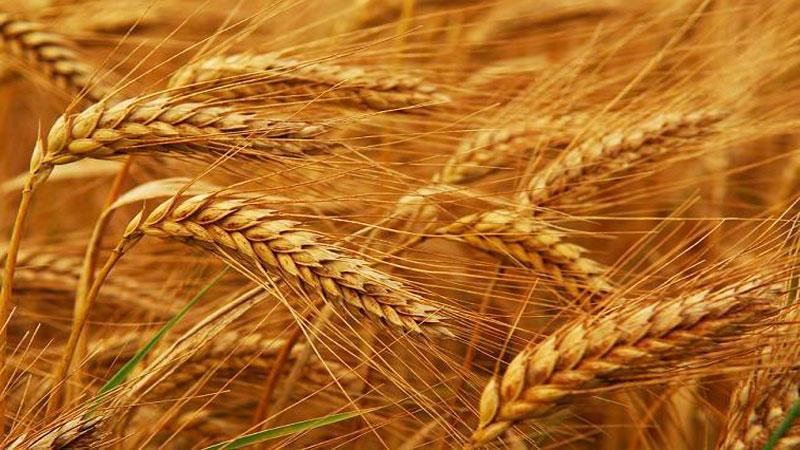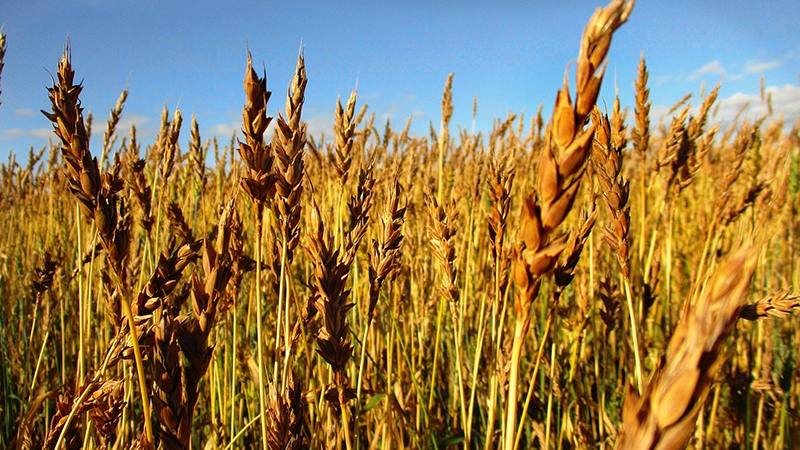What is soft wheat, how it differs from hard wheat and where is it used
Wheat is divided into two groups: hard and soft varieties. When buying flour products, it is useful to know what kind of flour they are made of. We will tell you what are the main differences between soft and durum wheat and whether there is a difference in their agrotechnical characteristics.
The content of the article
Features of soft wheat
Soft wheat is also called summer wheat. It is an annual species of herbaceous plants of the Wheat genus, the Cereals family, or Bluegrass. This type of plant was actively cultivated in the USSR. Despite the name, soft wheat is difficult to thresh, but high-quality, tasty bread is obtained from flour. It is divided into two types - winter and spring.
Botanical description

An annual herb belonging to the Cereals family. The root system is developed, it can go to a depth of 1 m. The stem is hollow inside, naked, with a height of 45 to 200 cm. Breeders deliberately breed low-growing varieties that spend less nutritional energy on straw, and more on grain formation. Another advantage of undersized varieties is lodging resistance.
The ears of this species are two-row, sessile, three- to five-flowered - the upper flower is mostly undeveloped. Grains are oval in shape, with a longitudinal groove, white, yellow, bronze or red. Wheat is a self-pollinating plant.
Historical reference
Archaeological excavations prove that soft wheat appeared about 6-8 thousand years ago in the countries of the Near and Middle East - on the territory of modern Turkey, Syria, Iran, Turkmenistan.
Wheat appeared in Russia in the 5th century. BC e. On the territory of modern America and Australia - much later: in South America - in 1528, in the USA - in 1602, in Australia - in 1778, in Canada - in 1802.Despite such a late appearance, soft wheat is in great demand everywhere.
For reference. In 1989, the total area under crops was 220 million hectares.
What is the difference between soft wheat and hard wheat
The main purpose of soft wheat is to make flour. The culture has a wide, but short ear, short awn, which is absent in some varieties. The main advantage is the high protein content in the composition.
Durum wheat is much denser in structure, the grains do not spill out when ripe. Outside, each spikelet is covered with an elastic film that gives a rich yellow tint and a pleasant smell. Most often, these wheat varieties are used to make pasta and semolina.
Differences between soft and durum wheat are presented in the table.
| Sign | Soft | Solid |
| Stems | Thin, hollow | Dense |
| Consistency, color | Glassy flour. Grains from white to red. | Tough. The color range varies from yellow to brown. |
| Content | More carbohydrates, starch and, accordingly, calories. | Fewer carbohydrates, lower calories. |
Grain composition
The grain of soft wheat contains water, nitrogenous substances, proteins, fats, complex carbohydrates - insoluble (starch, fiber, pentosans) and soluble (sugar, dextrins). The table shows the chemical composition of wheat grain as a percentage.
| Element | Content |
| Water | 14-15% |
| Nitrogenous substances | 13-15% |
| Fats | 2,3-2,8% |
| Starch | 65-68% |
| Sugar before processing | 0,10-0,15% |
| Sugar after grain processing | 2,5-3% |
| Cellulose | 2,5-3% |
| Pentosans | 8-9% |
| Ash content | 1,8-2% |
The chemical composition depends on various factors: the type of grain, its maturation, climatic conditions, the composition of the soil and the fertilizers used.100 g of unprocessed soft wheat grain - 305 kcal.
Classification

The main value of soft wheat is the ability to form gluten. This property allows the production of high quality bakery products. To determine the scope of use of grain, at the stage of drying and cleaning, classification culture according to several criteria. The worst result becomes decisive. Depending on the main characteristics, wheat is divided into 5 classes.
|
Name indicator |
Characteristics and limiting indicators by class | ||||
| 1 cl. | 2 cl. | 3 cl. | 4 cl. | 5 cl. | |
| Smell | Normal, which is characteristic of a healthy culture | ||||
| Colour | Matches Healthy Grains | ||||
| Mass fraction of gluten | 32% | 28% | 23% | 18% | Has no limits |
| Gluten quality | 45-75 | 45-75 | 76-100 | 76-100 | 101-120 |
| Falling number per second | Over 200 | Over 200 | Over 200 | Over 80 | Over 80 |
Milling properties
Milling of grain determines the possibility of obtaining an increased yield of flour after grinding with minimal energy consumption. Evaluation of milling is carried out according to the following indicators:
- flour output after grinding;
- duration of the grinding process;
- energy consumption;
- size, color of grain, ash content of flour;
- specific energy consumption.
Food
For the manufacture of bakery, pasta, high-quality and stable gluten is required. Its texture should be elastic, not crumbly. Too strong gluten may not stretch, but weak gluten, on the contrary, will be stretched.
Reference. Pasta is made from hard and soft wheat.
The production of pasta requires an elastic, resilient dough, so the wheat used for grinding flour must have a high nature, glassiness, and a high content of protein and gluten.
Applications
Mainly, soft wheat flour is used as a component in the preparation of bread and bakery products. In addition, malt is produced from grain - wheat beer is obtained. Not only grains are used, but also by-products from the processing of ears. For example, the bran left after grinding is used as feed for livestock.
Soft wheat is used in the industrial production of starch and alcohol. But these areas are not paramount from the point of view of the use of grain raw materials.
Economic
Despite the fact that food use is the main area of use for soft wheat, it is also suitable for economic purposes.... Hay is used to make bedding for the winter for livestock and roughage.
Starch and gluten allow using this culture in the manufacture of cardboard, paper, packaging material. Craftsmen weave straw hats and baskets from dry stems.
Medicinal
The culture has no less medicinal properties than food and economic ones. Not only bakery products made from flour are considered useful, but also sprouted grains, cereals, tinctures, oils. Soft wheat removes toxins from the body, treats various diseases: gastrointestinal disorders, respiratory system diseases, skin abscesses, etc.
Growing geography
Soft wheat is the most common grain crop. It gained its popularity due to its undemanding soil. Some varieties have climatic restrictions (temperature - from 25 to 40 ° C).
The most favorable regions for cultivation - the territory of Europe and Australia. On European lands, these are steppe and forest-steppe zones. In Australia, it is also mainly a steppe region. Also, the culture is in demand in South and North America, where it is planted on the prairie and pampa. In the vastness of the Russian Federation, 26-28 centners per hectare are collected.
Features of agricultural technology

Winter and spring varieties are planted in Russia. At the same time, soft wheat occupies about 95%, 45% of this figure is winter. It takes root best in the central and southern regions, it is resistant to frost down to -35 ° С.
Attention! Snowless winters can destroy crops.
For soft wheat, fertility and soil moisture are important when planting.Winter varieties are more demanding on moisture, especially during the germination period. After germination, the crop is more resistant to drought than the spring crop.
On fields with high soil acidity, limestone is chosen as a top dressing. In the spring, the soil is enriched with nitrate and urea if there is not enough nitrogen in it.
Collection and storage
Spring varieties are harvested by combining when the plant reaches 15-20% grain moisture.
Attention! It is impossible to be late with the harvest of spring wheat, because when the crop is idle for 10-12 days, the quality of the grain deteriorates, the yield decreases, and the shelf life is reduced.
Winter varieties begin to be harvested by combining only after full maturation. Harvesting times vary by region. Harvesting takes place after reaching 14-17% grain moisture. Winter crops can be harvested in a separate way, but this entails large yield losses.
After harvesting, the grain is sent to elevators, where storage is affected by such factors:
- humidity and air temperature in the storage;
- the intensity of biological processes that occur in different layers of the grain;
- presence or absence of harmful organisms, parasites, insects.
Before laying crops in storage, the grain is thoroughly dried. The ideal storage temperature is from +10 to + 12 ° C. Compliance with these conditions allows you to minimize crop losses after storage.
Common wheat varieties
The ears of soft wheat are shorter and thinner than those of solid... The dough made from such flour is less elastic and looser, therefore it is ideal for making confectionery.
Winter crops
Winter wheat varieties resistant to cold weather. They are recommended plant from early September to late October. As a rule, these varieties give high yields:
- Antonovka. Height - 95 cm, ears of white shade without signs of drooping. The culture adapts to different weather conditions, is resistant to drought and various diseases. Ripens in 280 days.
- Bezenchukskaya. The weight of 1000 grains can reach 45 g, the grain is amber, dense ear. The plant is resistant to disease. The ripening period is 320 days.
- Lennox. The plant rarely exceeds 20 cm in height, in one spikelet - up to 200 grains, yield - 90 centners per hectare. Ripens in 300 days.
- Podolyanka. Height - 1 m, egg-shaped grains contain a large amount of fiber. The culture is resistant to the dry period, the yield is 60 centners per hectare. Ripening period - 310 days.
- Tanya. 1000 grains weigh 45 g. The crop has a high nutritional value, does not crumble, tolerates unstable climatic conditions, and is resistant to diseases. The ripening period is 300 days.
- Ilias. Plants do not exceed 1 m in height, spikes are boneless, not lodging, and tolerate a drop in temperature. Productivity - 75 centners per hectare. Ripens in 200 days.
- Lars. It has a high protein content, is resistant to frost, yield - up to 70 centners per hectare. The weight of 1000 grains can reach 50 g. The ripening period is 320 days.
- Favorite. Does not tolerate drought, requires timely watering, tolerates frost. Grains contain about 35% fiber. Productivity - 90 centners per hectare. Ripens for 280 days.
- Shestopalovka. Above 90 cm in height, ears of a pale green hue, are not subject to lodging and shedding of grains. Harvest per hectare of land - 80 centners per hectare. Ripens in 285 days.
Spring
Spring wheat varieties are sown in early spring. They do not require special tillage, but are vulnerable to climatic conditions. Popular varieties:
- Irene has large grains and high nutritional value; grains contain a large amount of protein, fiber and vitamins. Fruiting in 90 days.
- Novosibirsk 31 has a high nutritional value, is resistant to various diseases, but its yield is small - 36 centners per hectare. The ripening period is 100 days.
- Saratov 7. Spikes and grains of white color, yield - 45 centners per hectare, not susceptible to diseases. The ripening period is 90 days.
- Uralosibirskaya. Plants exceed 1 m in height, the maximum yield reaches 50 centners per hectare, matures for 85 days.
- Kharkiv 46. The ears are bright red, the grains are white. Used in bakeries, moderately resistant to disease, matures in 85 days.
Conclusion
The wide demand for soft wheat is promoted by the unpretentiousness of this crop to climatic conditions and the milling properties, which make it possible to produce high-quality products. It is suitable for growing in adverse conditions, therefore it is used in many regions of our country.